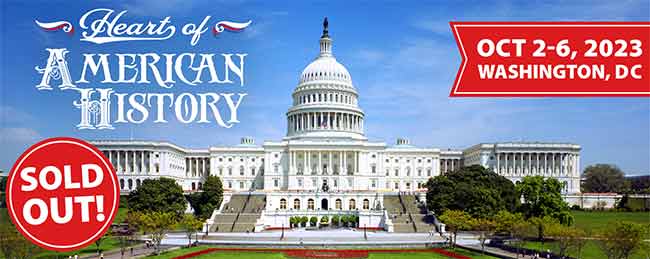
The Battle of Brandywine, September 11, 1777
 he American cause in the War for Independence had gotten a life-saving boost in the victories George Washington scored over the British army in the Christmas surprise at Trenton and the follow-up at Princeton in the winter of 1776-77. General Howe, commander of the British forces in America, called into question his decision to capture Philadelphia without substantial reinforcements, and so wrote to Lord Germaine who was trying to run the war from London. In March 1777, Germaine wrote Howe to continue his plans to take Philadelphia, but could only count on 3,000 more troops, far below the 7,000 Howe thought necessary to secure Pennsylvania. Another British expeditionary force under General “Gentleman Johnny” Burgoyne was launched from Canada against New York, and Germaine almost changed his mind to send Lord Howe to assist in New York. But the winds of providence sent Howe to Pennsylvania to meet George Washington along the Brandywine River near Chadd’s Ford, a hop, skip and jump from Philadelphia. In May, Howe received the orders and set in motion the invasion of Pennsylvania. he American cause in the War for Independence had gotten a life-saving boost in the victories George Washington scored over the British army in the Christmas surprise at Trenton and the follow-up at Princeton in the winter of 1776-77. General Howe, commander of the British forces in America, called into question his decision to capture Philadelphia without substantial reinforcements, and so wrote to Lord Germaine who was trying to run the war from London. In March 1777, Germaine wrote Howe to continue his plans to take Philadelphia, but could only count on 3,000 more troops, far below the 7,000 Howe thought necessary to secure Pennsylvania. Another British expeditionary force under General “Gentleman Johnny” Burgoyne was launched from Canada against New York, and Germaine almost changed his mind to send Lord Howe to assist in New York. But the winds of providence sent Howe to Pennsylvania to meet George Washington along the Brandywine River near Chadd’s Ford, a hop, skip and jump from Philadelphia. In May, Howe received the orders and set in motion the invasion of Pennsylvania.
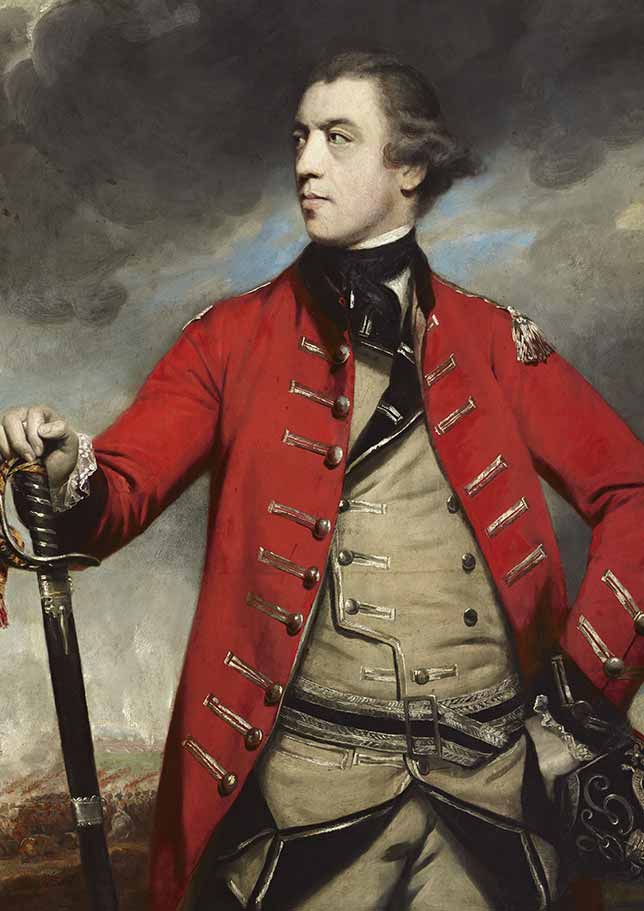
General John Burgoyne (1722-1792)
|
|
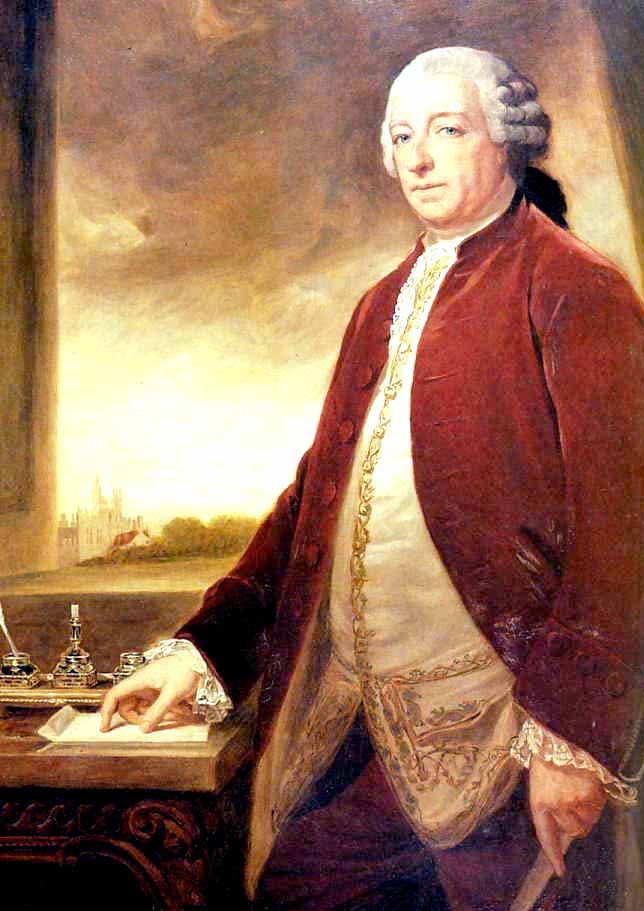
Lord George Germaine (1716-1785)
|
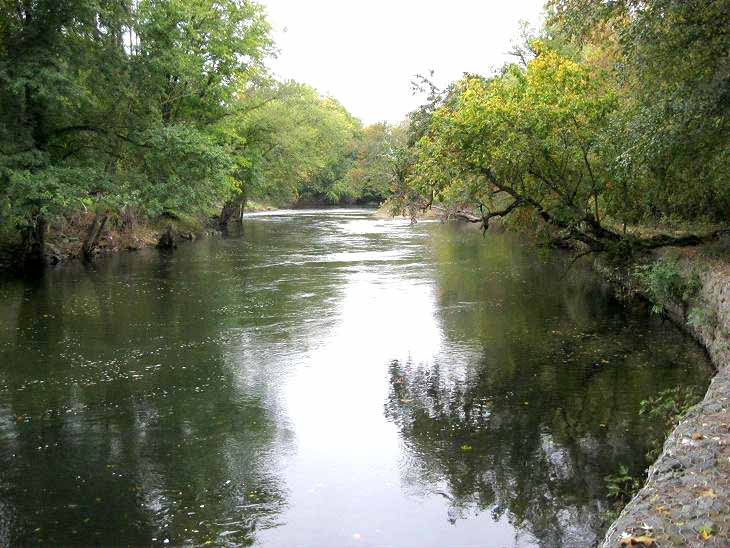
The Brandywine Creek at Chadd’s Ford
By July, the troops were aboard transports preparing to sail from their billets in New York City to the Delaware River and move upon Philadelphia. Only General Cornwallis and Brigadier General James Grant were told where they were headed. Many, including Washington himself, thought the redcoats might sail north to help Burgoyne. In fact, orders to that effect had been sent from London but did not arrive until August, after General Howe had embarked on the Pennsylvania Campaign. God controls the ocean communication currents also.

General Charles Cornwallis (1738-1805)
|
|
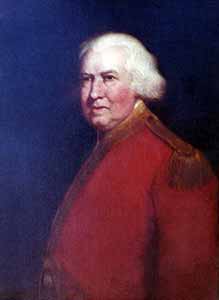
General James Grant (1720–1806)
|
The defensive fortifications on the Delaware River convinced Howe to flank their way into Philadelphia via Chadd’s Ford. As Washington realized the British forces were headed to Philadelphia, he sent orders for American General “Mad” Anthony Wayne to gather the Pennsylvania militia, and sent reinforcements to defend supply points potentially within enemy reach. He had to solve supply and discipline problems and consult with Congress concerning the coming campaign and possible evacuation. By mid-August, Washington was “again befuddled concerning Howe’s objective”, but a reliable report came on August 22 that the British fleet was in the Chesapeake Bay. Calls went out for Delaware and New Jersey militia to join Washington’s forces. On August 24, the commander-in-chief conducted a grand march through Philadelphia to encourage the town’s people with a show of strength in the coming crisis.
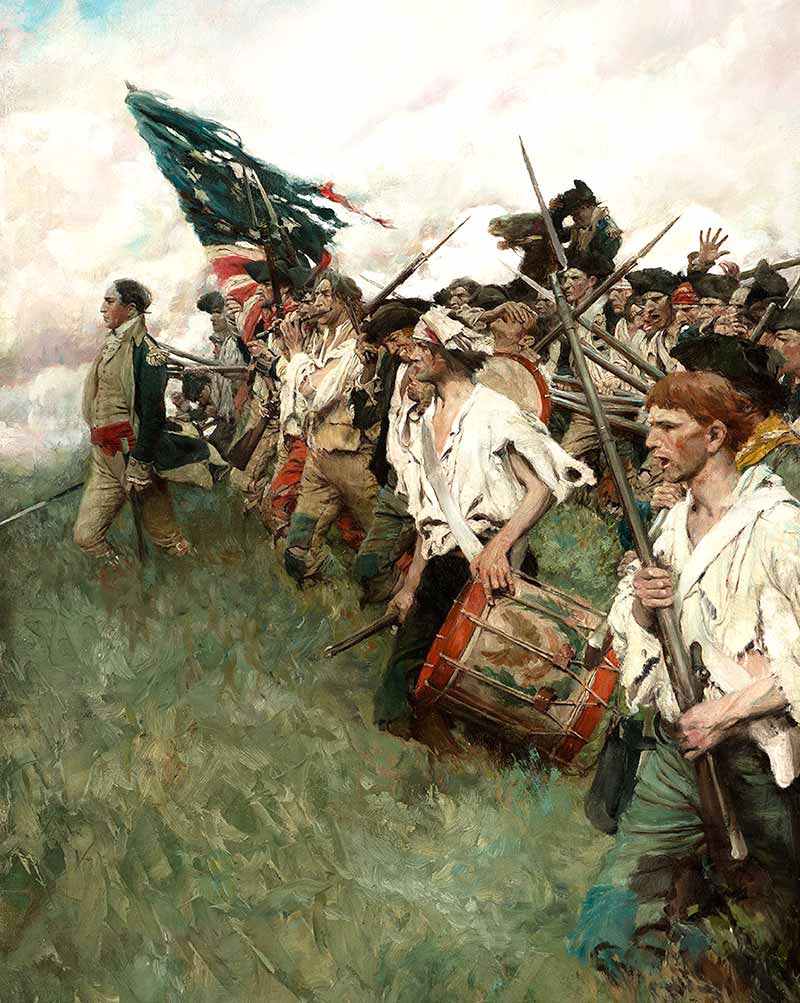
Howard Pyle’s iconic painting, Nation Makers, depicts American troops at Brandywine and is displayed at the Brandywine River Museum
The British army aboard the ships had a miserable voyage—one German officer wrote that the bread had worms, the water stunk, the meat was inedible and the ship was full of lice. After almost two months aboard ship, about sixty German and English soldiers died on the voyage as storms battered the fleet. Four hundred horses were lost at sea. Despite the inauspicious beginning of the campaign, the redcoats finally landed unopposed at Head of Elk, Maryland. Despite five hundred soldiers sick and unable to continue, the British force moved north toward the Brandywine River where the Americans waited. A few army deserters and Tories from Philadelphia provided all the information General Howe needed to conduct his tactical operations.
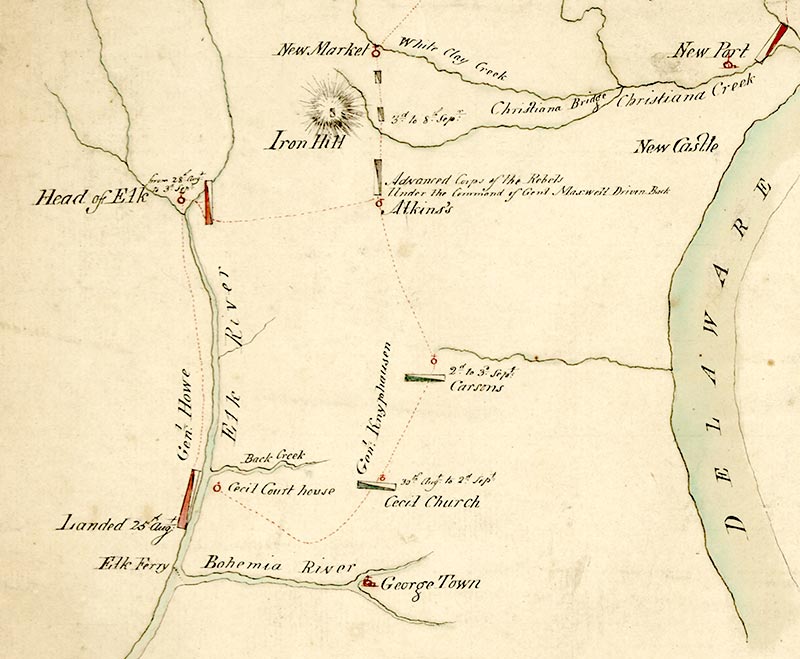
Detail of a 1777 military map: Cooch’s Bridge is just to the right of Iron Hill; Philadelphia is off to the northeast; Head of Elk can be seen on the left along the Elk River. The Brandywine River is marked here as Christiana Creek, an alternate name.
On September 3, the Americans fought a delaying action at Cooch’s Bridge, the only battle of the war fought in Delaware. The Hessian brigades pressed on and Washington’s advance forces fell back to Chadd’s Ford, just over the Delaware line in Pennsylvania. The stage was set for the great Battle of Brandywine on September 11 that doomed Philadelphia.
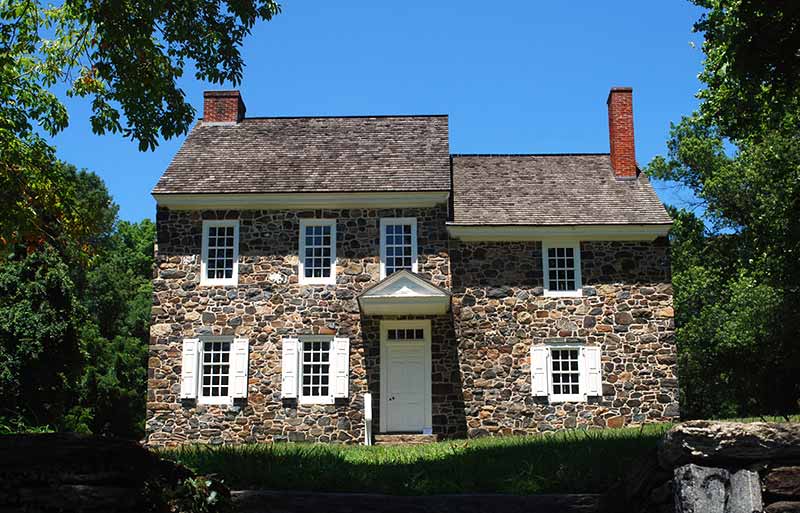
Washington’s Headquarters at the Battle of Brandywine
Washington decided to make a stand behind the Brandywine River. He took over several local Quaker homes as headquarters and called together his brigadier generals and senior staff members, including Nathanael Greene, Henry Knox, John Sullivan, William Alexander (“Lord Stirling”), the Marquis de Lafayette, Anthony Wayne, and a few others of high rank who would do great service over the next few years, like Alexander Hamilton, John Peter Muhlenberg, Israel Putnam, and Casimir Pulaski, all men whose names were commonly known by American school children until the 1960s. Remembering well the British penchant for flanking attacks, Washington was zealous to protect the fords and subsequently gathered a number of local patriots known for both their loyalty and knowledge of the terrain.
|
SAVE THE DATE: Join us next spring in Philadelphia, site of the Continental Congress & signing of the Declaration of Independence. Follow General Washington from his loss at Brandywine, to his Delaware crossing & surprising victory at Princeton, & much more! Learn More > |
|
 |

A Hessian map of the Philadelphia area at the time of the Battle of Brandywine
A company from Canada—recruited near Albany, NY—guarded one of the fords and another guard was commanded by a former officer in the British Highland Regiment, the 44th Foot. No doubt he did not fancy getting captured by his former regiment (popularly known as The Black Watch). The night before the battle, the Rev. Jacob Trout preached a powerful and motivating sermon to the troops and Washington wrote that he hoped a kind providence would be their lot on the morrow.

The Brandywine Battlefield today
Lord General Charles Cornwallis and His Excellency Lieut. General Knyphausen (Howe’s wing commanders) set out for the crossings at dawn the next morning. The two sides collided a mile from Chadd’s Ford and the battle was on. Howe intended to pin the Americans in position there, while a flanking column with the other half of the army crossed far above the main ford to strike on the flank. Washington sent patrols to discover the whereabouts of what proved to be 7,000 picked men commanded by Howe himself, marching to flank the American army. Conflicting reports from scouts delayed Washington’s response, allowing the British force to cross upriver and attack on the flank and rear of the American line. Generals Stephens and Alexander were sent to confront Howe at the Birmingham Meeting House northwest of his main position. The battle surged back and forth with great acts of heroism and high casualties, but in the end, the Americans were forced to fall back and yield the day to General Howe. Washington himself, providentially and unknowingly, escaped death from the best rifleman in the British army who would not pull the trigger on an enemy soldier with his back turned.
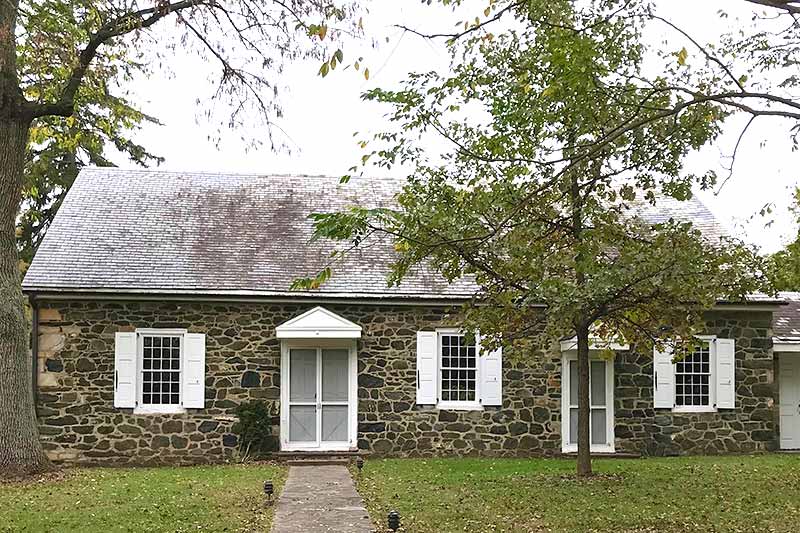
The Birmingham Friends Meetinghouse on the Brandywine Battlefield today
At the cost of about 1,300 American casualties and perhaps more than 1,700 British and Germans, Howe had opened the road to Philadelphia. The Congress escaped capture, Washington kept his army together at Valley Forge, and General Burgoyne began the battle eight days later in New York that lost him his army, and, in the long run, the war. Victories are often temporary.
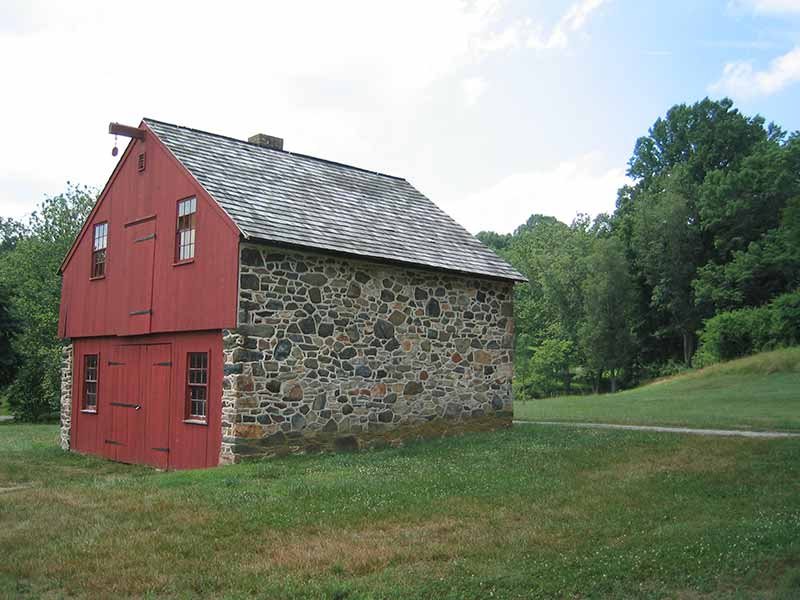
The Brandywine Battlefield today


For further study, read September 11, 1777: Washington’s Defeat at Brandywine Dooms Philadelphia, by Bruce E. Mowday.

Image Credits:
1 Burgoyne (wikipedia.org)
2 Germaine (wikipedia.org)
3 Chadd’s Ford (wikipedia.org)
4 Cornwallis (wikipedia.org)
5 Grant (wikipedia.org)
6 Nation Makers (wikipedia.org)
7 Philadelphia Map (wikipedia.org)
8 Washington’s Headquarters (wikipedia.org)
9 Hessian Map (wikipedia.org)
10 Brandywine Battlefield (wikipedia.org)
11 Birmingham Friends Meetinghouse (wikipedia.org)
12 Brandywine Battlefield (wikipedia.org)
|






